People
The project area lies in the ethnogeographic zones of Bisonhorn Marias, Jhoria Murias and Raja Murias (Elwin 1936). Our study was mainly aimed at the economic life of the people in the impact area. A broad view of the sociocultural life of the people may help to have a holistic view of the possible impacts of submergence and resettlement of the people. This would also assist in visualising the impacts of such resettlement on the forest and wildlife values in the rehabilitation areas.
Tribes and Castes of the Project area
Bisonhorn Maria, Jhoria Muria, Raja Muria (all Gond tribes) and Halba are the tribes found in the study area. Dhakar (Cultivator Warrior), Rawat (cowherd), Kalar (distillers) Maharas (scheduled caste), Lohars (blacksmiths – sheduled caste), Dora (fisherman) and Brahmin represents the different castes of the study area.
Language
Halbi is the common dialect for people in the study area but Gonda is also spoken by the Gonds living in the area. Most of them also speak Hindi
Religion
Gond tribals follow a religion of their own (Tribal religion). The Gonds are predominantly animistic (belief in spiritual beings) and their norms are influenced by Hindus. Belief in ghosts. Spirits, phenomenon of possession , animal worship, tree worship, Rain God, Hill God, the “Earth Spirit” are among the elements of Gond animism reported by anthropologists (Mehta 1984)
Danteshwari Devi, the Hindi Goddess is worshipped by all people of Bastar. Halba and Raja Muria are more Hinduised tribes (Huber 1988). The Hindu casts (including oriya Brahimns) and tribals in the same village are having common places of worship (Deo-gudi) and gods and deities of tribal origin. “Village mother”, earth and clan-gods (deities of each clan) are worshipped by all people in the village.
People tend to be superstitious and Pujari, Sirha (medium of God) and magicians are well respected by them.
Family and Marriage
Families are partriarchal with equal status for woman in social roles and functions. Clan exogamy is seen among tribal marriage choice. A tribe consists of Phratries (Saga) which include many clans and subclans. Each clan is related to totem (respected animal or object). These Phratries and clans help to regulate marriage.
Recreation
Hunting, dancing and singing are the main recreational activities of the people. Children going to forest with bows and arrows is a common sight in the forests of Bastar.
Village community
Villages are non nucleated and composed of hamlets (Para). A para generally consists of the same tribe or caste. Deoigudi (temple), Thana-gudi (rest house) are constructed by common efforts. Patel, Sarpanch, Kotwar, Aaith pahari and Rawat have their own managerial roels to play on different occasions in the village.
Even though in social hierarchy Mahars re at the bottom and Brahmins on top, no untouchability or disharmony is noticed.
Weekly market places situated in an average 10 km apart are the only places of transactions. Indravati river and some of its tributary nalas in their lower reaches are the main sources of drinking water, although some government bore wells area also in use in some villages. Health facilities are not adequate and health centers are 8 to 10 km away form most of the villages. Veterinary service is neither available nor sought for tribal livestock. People are generally illiterate. Lack of motivation from tribal parents and irregular attendance of teachers undermine the utility of schools.
Because of the proposed dam and consequent likely submergence, no developmental programmes have been implemented in these villages for the last ten years. Co-operative movement is very weak and not seen. Non-statutory bodies like tribal panchayat and village panchayat have a control on village level activities.
Composition and characteristics of population
Forty two villages are located in the submergence and construction area of the project of which 28 require full relocation and 5 partial relocation (MPEB Records). Four are deserted forest villages and in 5 villages only land will be affected partially.
1748 families are planned to be relocated. Out of which 8775 people affected, 6209 (70%) are tribals and scheduled castes and the remaining are is 63/sq km, which is more than the district average (47/sq km).
Cultivation of paddy on permanent fields provided the most major source of sustenance to the people. 736 families (42%) of the families are landless. Food gathered from forests and other forest based supplementary of livelihood supply bulk of the remaining subsistence. Eight villages were selected for sample study to cover the different mixes of dependencies, so as to represent the entire impact area.
Characteristics of sample villages and households
|
No. of villages |
8 |
|
Total population |
3069 |
|
No. of Hamlets (Paras) |
30 |
|
No. of Households |
129 |
|
Population sampled |
900 |
|
Average Household size |
7 |
|
No. of landless households |
35 (27%) |
|
Land holdings upto 5 acre |
48 (37%) |
|
Land more than 5 acre |
46 (36%) |
|
Scheduled tribe households |
55 (45%) |
|
Scheduled caste households |
31 (24%) |
|
Other Hindu castes |
43 (33%) |
(Population of the sample villages are given in appendix – 7.1)
Economy and occupation
Production is mainly for home consumption. A small surplus of agricultural and forest produce is small surplus of agriculture and forest produce is sold to enable purchasing commodities like salt, kerosene, cloth etc. Besides agricultural products, food gathered from forest contributes substantially to their mainstay. Tribal dependence on forest is discussed in detail in this report.
An activity calendar (Table 7.1) shows the cycle of annual activities and the tribal-forest relationship (dependence) and seasonal variation in it.
Table 7.1: Calendar of subsistence activities
|
Main activity |
Months |
|||||||||||
|
Jan |
Feb |
Mar |
Apr |
May |
Jun |
Jul |
Aug |
Sep |
Oct |
Nov |
Dec |
|
|
1. Cultivation & Agricultural labour |
== |
== |
== |
== |
== |
|||||||
|
2. Collection of Mahua flower and tamarind fruits |
== |
== |
== |
|||||||||
|
3. Collection of tendu leaves, sal, harra, beheda, kosum, mahua seeds |
== |
== |
||||||||||
|
4. Collection of honey, and resins, etc. |
== |
== |
== |
|||||||||
|
5. Collection of tubers, bambooshots, mushrooma etc. |
== |
== |
== |
== |
== |
|||||||
|
6. Collection of forage and fishing |
== |
== |
== |
== |
== |
== |
== |
== |
== |
== |
== |
== |
|
7. Forest labour |
== |
== |
== |
|||||||||
|
8. Hunting, netting and trapping of animals |
== |
== |
== |
== |
== |
|||||||
|
9. Making of basket, mats, traps etc. |
== |
== |
== |
== |
== |
== |
== |
|||||
|
10. Repair of houses, fence, agri. implements and storage of fuel wood. |
== |
== |
== |
== |
== |
|||||||
Cultivation and related works are the most important activities and occupies much of their time in about five months in a year during the rainy season and upto the middle of winter. However, during rainy season, once the crops are sown they collect mushrooms, tubers, bulbs and bamboo shoots from forest as these make their main food. They rarely go to weekly markets during this period. Collection of tubers and mushrooms is generally done by women folks. After agricultural works are over, Gonds start going to forest for collection of fuel wood as well as for hunting and trapping animals. This activity tapers off in March and is followed by ‘Parad’, (community hunting). They to for ritual hunting on an average thrice during the open season and the whole village participate in this hunting. Bamboo articles like baskets, mats and traps for sale or for domestic use are made during the open season. March to June is the busiest time for most of the people. Collection initially of mahua (Madhuca indica) flower and later of mahua seeds keep them busy during March to June. They also collect honey (Plate 7.1), seeds of sal (Plate 7.2), (Shorea robusta), harra (Terminalia chebula), behada (Terminaia belerica), kosum (Schlichera oleosa) and mahua (Plate 7.3) as well as leaves of tendu (Diospyros melanoxylon). They also derive wages by working in the forest on timber operations, road maintenance etc. during this season. M.F.P. collection and wages from working in the forest contribute to their income in a good measure. At the end of summer they repair their houses, fencing, agricultural implements and start storing fuel wood for the monsoon period. Fishing and collection of forest greens are the other small scale activities throughout the year (Plate 7.4).
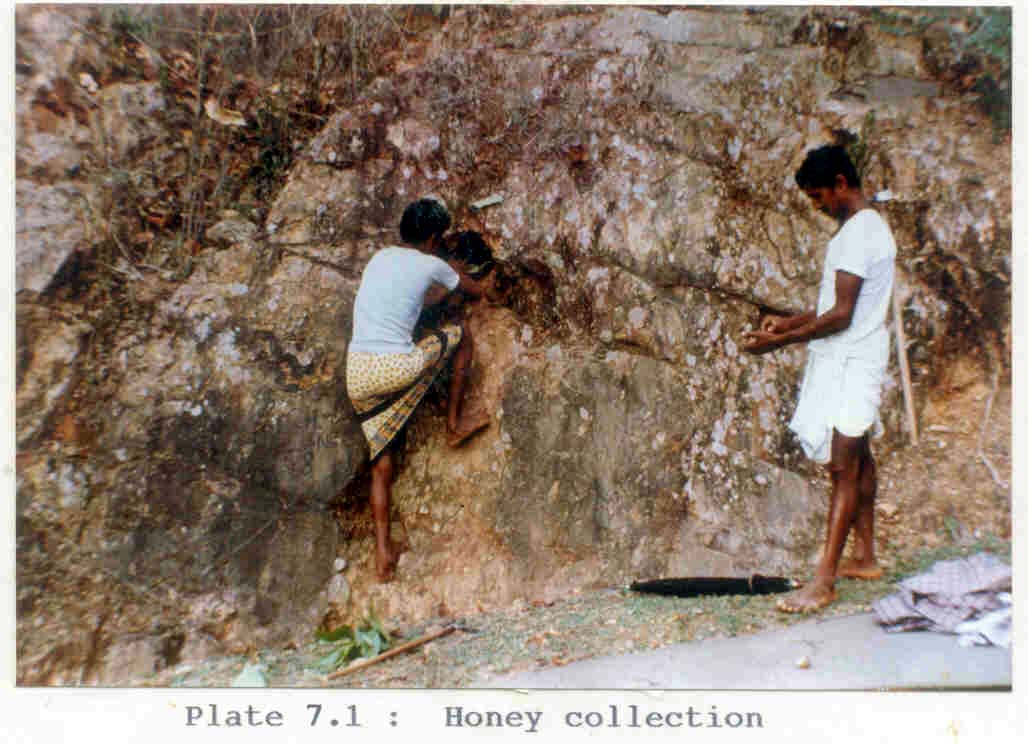
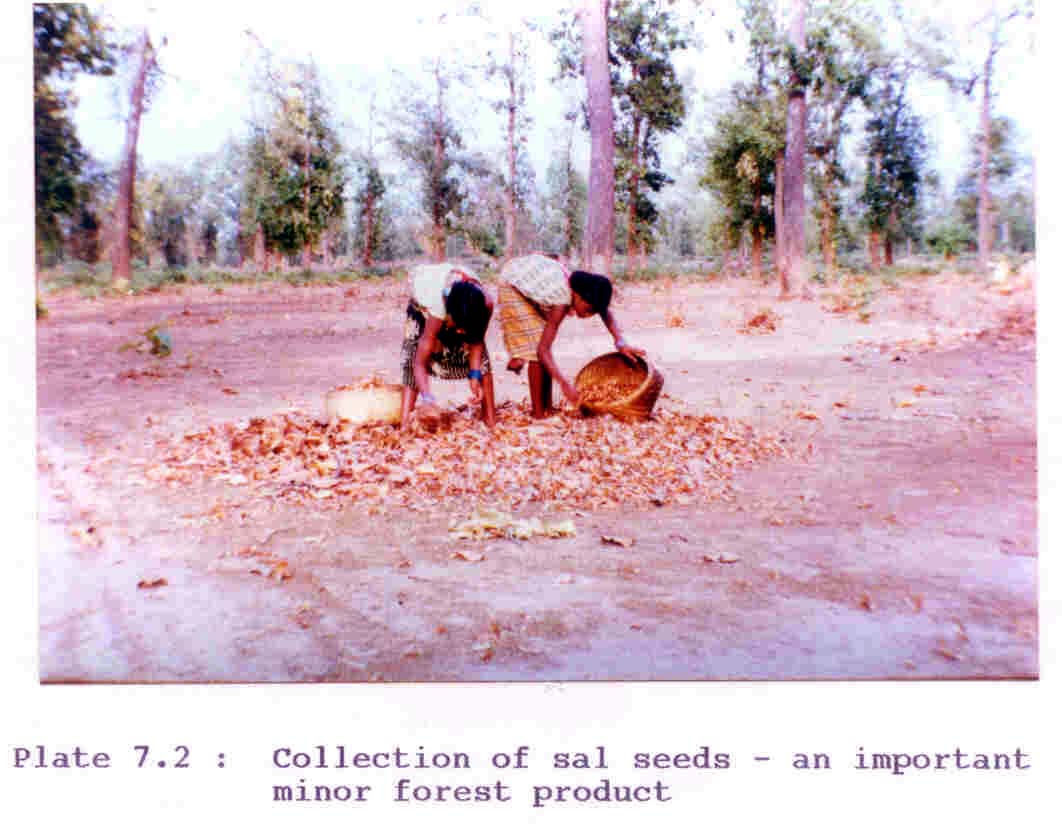

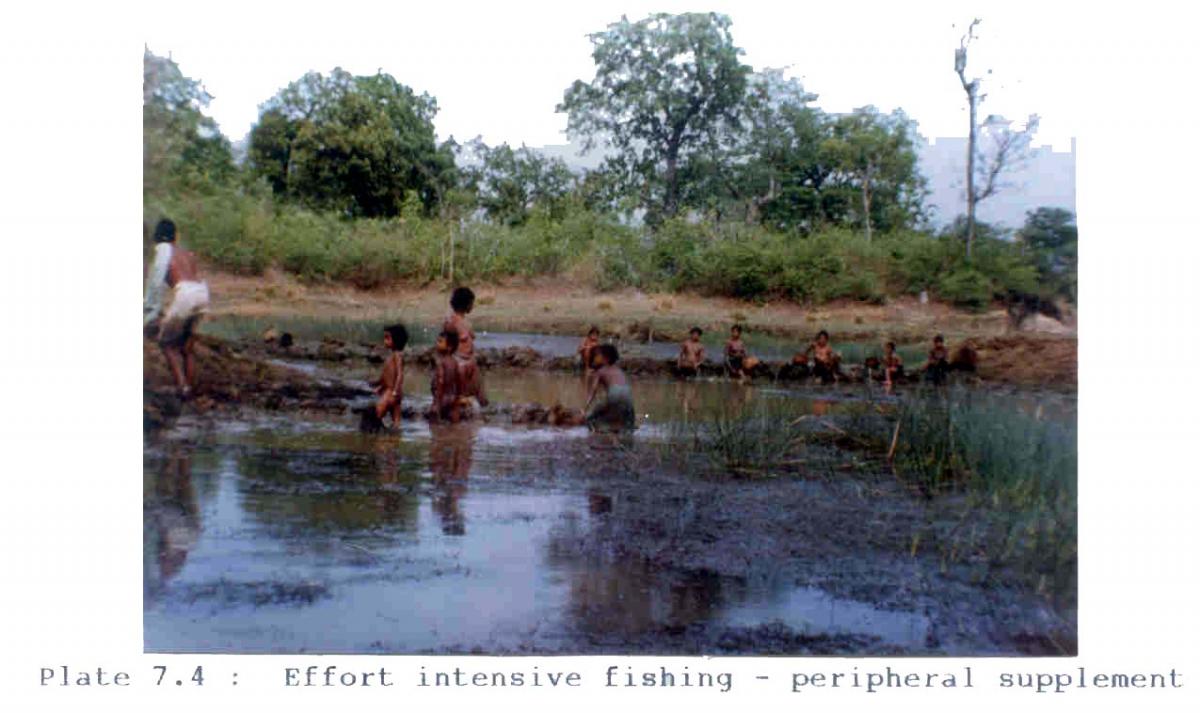
The calendar of their main forest dependent activities brings out the importance of forests in their economy. Except for Oriya Brahmins and a few villages in the eastern segment, this calendar is more or less common for all tribes. In eastern segment villages, the adjacent forests have become degraded from over exploitation in the past and hardly any MFP is available. The activities are hence now mainly confined to agriculture.
Extent of dependence of forest
Direct economic dependence of people on forest isfor
i. Energy in the form of fuel wood.
ii. Shelter in the form of timber, bamboo, wooden poles, thatching leaves and ropes.
iii. Food in the form of mushrooms, tubers, bulbs, bambooshoots. Fruits, seeds and forest greens.
iv. Other uses like ropes of climbers, sal leaf plates (locally called Dona), raw materials for making bows and arrows, umbrellas, traps, baskets, mats, pots and wooden household utensils.
v. Income from minor products like sal seed (Shorea robusta), harra (Terminalia balerica) seed, kosum (Schlecheira) seed, kirich (Casearia graveolens) seed, karanji (albizia procera Benth) and mahua (Meduca indica) flowers and seeds, mango fruits and seeds (in the case on landless people) and tussar sillk cocoon (kosa).
vi. Income from tendu leaves collection.
Indirect dependence of people on forest is for:
i. Cultivation.
ii. Income from forest labour like in timber operations, construction of forest roads.
iii. Agricultural fertilizers (burnt ash of forest litter).
iv. Timber for agricultural implements etc. like wooden plough, yoke, mutela, (mud block breaker) and handles for spade, sickle etc.
v. Pasturing of livestock which generate income from sale, work as draught cattle and provide manure.
vi. Income from fishing and alternate employment.
On the basis of dependence, villages can be grouped into two categories viz. (1) villages with good forest around them and (2) villages with degraded forest around them. In the sample villages, dam side villages or the villages of the western segment including Koyam, Neurnar, Puspal, Malewahi, Erpund and Harrakider can be placed in the first category. Distant villages or the villages of eastern segment like Sataspur and Bunta can be placed in the second category.
Direct dependence on forest
1. Food
In the submergence area, people still follow traditional (broadcast sowing) method of cultivation and production is mainly for consumption. A small proportion of the produce is sold to meet other needs like clothes, salt etc. Fish also supplements their food to a small extent and a small cash income is also derived from sale of fish (Plate 7.5).
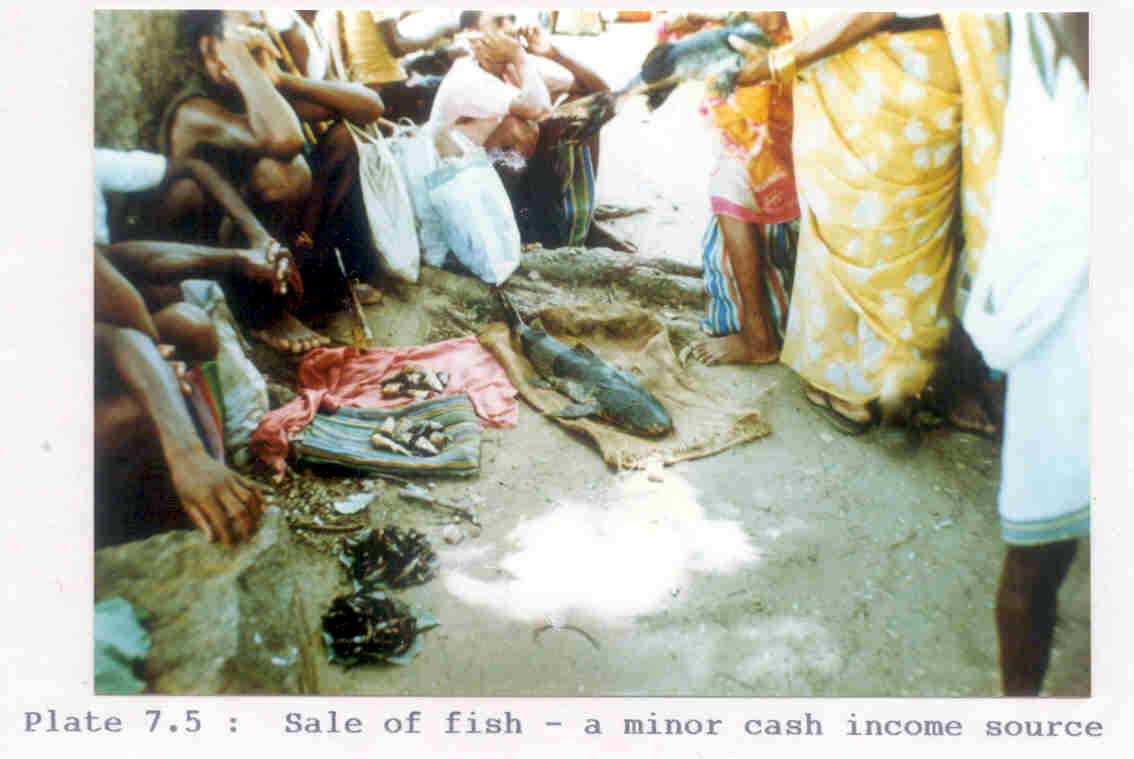
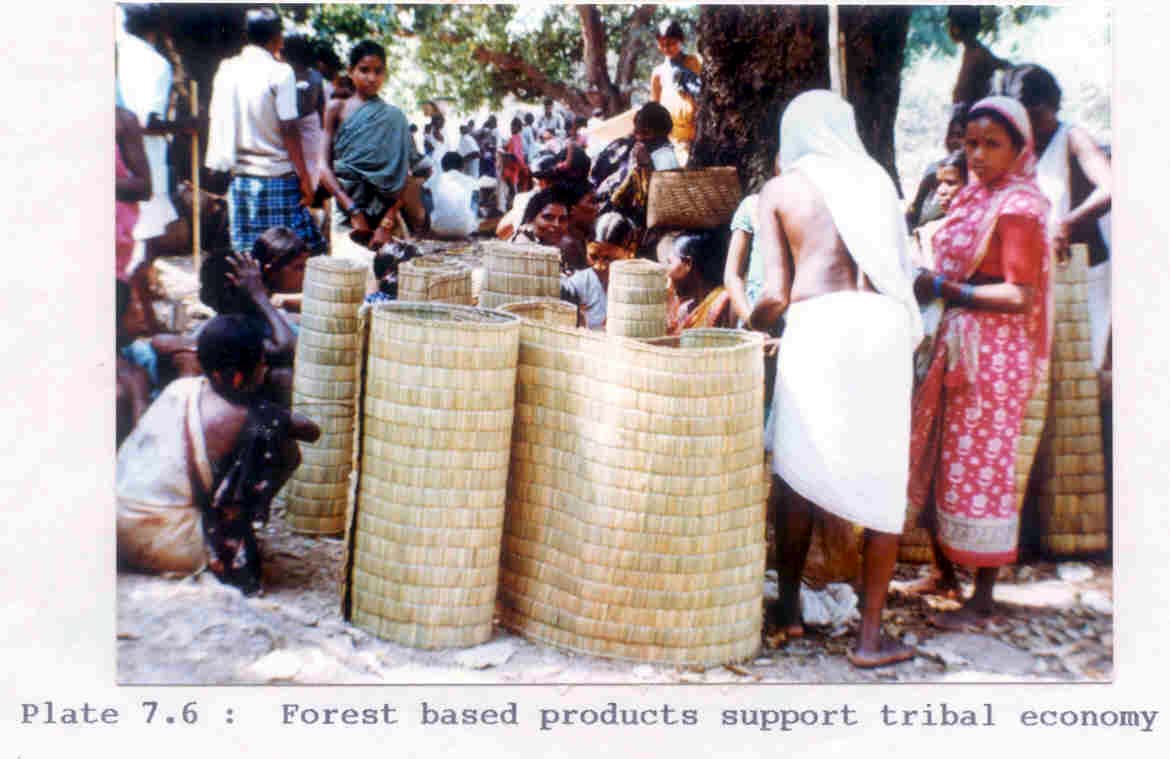
Forest food consist of mainly leafy vegetables, forest greens, bulbs, tubers, mushrooms, bambooshoot, edible fruits, seeds, flowers, red ants, honey, birds and other hunted animals. Eight species of forest greens, six species of wild tubers and roots, two species of mushrooms, 22 species of wild fruits, eight species of edible seeds (three species of oil seeds) are consumed widely (Appendix 7.2). They use traps, nets, bows and arrows (poisoned heads) to hunt animals including hare, monkeys, deer, wild boars, squirrels, rats, jungle fowls, pea-fowls, partridges, quails and other birds and fishes. In the last parad, three wild boars, one chital, one barking deer, four langurs, one hare, two peafowls, five junglefowls, and three giant squirrels were reported to have been killed by the inhabitants of the eight sampled villages.
On an average 126 kg (range: 102-183 kg) of forest food is consumed every year by each family (Appendix 7.3). Consumption and dependence varies with season. During monsoon people are more dependent on forest food, but in summer major share of vegetables is either from ‘badi’ (fenced compound) of weekly market.
2. Shelter
Construction of house, cattleshed, pig-sty, shed for haystack, fence, watch-tower etc. requires timber, bamboo, rope and thatching material. All of these needs are met from forest. On an average 75 wooden poles (of 40 cm girth x 3 m length), 100 bamboo poles or thin wooden poles (less than 20 cm girth) and 75 kg thatching leaves are required for family. Thatching leaves are required only for 38% of the households (thatched ones). Use and quantity of these construction materials vary according to availability of the products (condition of forest). In the villages in the eastern segment of the study area big country tiled houses and permanent mud wall fencing are seen (for Brahmin Houses). Tribals houses are small, country tiles or thatched. Separate constructions for storing grains and mahua, for sleeping, and for cooking are seen in some households. For cattle shed, pigsty and hay stack they use poles of more than 50 cm girth. Watch towers are constructed in paddy fields to protect the crop from animals.
Thana-gudi and Deo-gudi are common for all villagers and are constructed by the village panchayat. For fencing, bamboo poles are generally used but big timber poles and sometimes thin poles are also used depending upon availability. Fencing is done around the house as well as around the compound. Construction is dime by the family itself, sometimes using the “betia” system of exchange of labour (co-operation).
3. Energy
Fuel wood is used for cooking, warmth and lighting. During winter months, fuel wood consumption is 3 times more than that in other months. Each household uses 9 kg fuel wood on an average for cooking per day. 15 kg of wood per day is used for keeping “aggadda” (fire place) for warmth in winter months. 5 tons of fuel wood is estimated to be consumed by a household every year (Table 7.2).
Table 7.2 Fuel wood consumption
|
Village |
For cooking/day (kg.) |
WINTER (NOV.-FEB.) |
OTHER MONTHS (MAR.-OCT.) |
|
For warmth & light/day (kg.) |
Total/ day (kg.) |
Total/ day |
|
|
Total/ season (kg.) |
Total/ season (kg.) |
Use of kerosene oil is very limited. In tribal houses a small log of wood can be seen burning always, because they rarely use matches. All of the fuel wood comes from the forest.
Other uses
Raw materials for making baskets, mats, umbrellas, bows and arrows, traps, nets, pots, rope, plate and household utensils and tools are collected from forest (Plate 7.6 & 7.7). Bauhinia vahliiU, Grewia tilliaefolia, and Grewia rothii are generally used for making ropes.
A type of gourd is used as pot (tumbi) for carrying ricegruel (pej) and sulphi (sago palm juice). Thin strips of bamboo splits and leaves of Bauhinia vahlii are used for making umbrella as well as vessels to store grains. Bamboo is used for making baskets, mats, bows, traps and nets. For making plates leaves of sal, mahua or tendu are generally used.
Income from Minor forest products
Honey, seeds of sal. Kirich, karanji, chironji and kosum, fruits of harra and baheda, tendu leaves and wild silk worm cocoons (kosa) collected from forest floor are the main forest products which are direct income sources (Appendix 7.4). About 13% of actual income of dam side villages and 5% of actual income of overall sample households are derived from the sale of minor forest produces (Appendix 7.5). Landless people and tribals are comparatively more dependents on minor forest products. The main species of trees/plants, whose produce and other materials derived from forests, are as follows:
1. Shorea robusta (Sal) – seed
2. Terminalia chebula (harra) – fruit
3. Terminalia bellirica (baheda) – fruit
4. Buchnania lanzan (chironji) – seed
5. Scheichera oleosa (kosum) – seed
6. Holarrhena antidysenterica (kirich) – seed
7. Semecarpus anacardium (bhelva) – fruit and seed
8. Madhuca indica (mahua) – seeds and flowers
9. Diospyros melanoxylon (tendu) – leaves and fruit
10. Emblica officinalis (aola) – fruits
11. Mangifera indica (mango) – fruits
12. Honey
13. Kosa (wild silk cocoon growing mainly on Terminalia tomentosa)
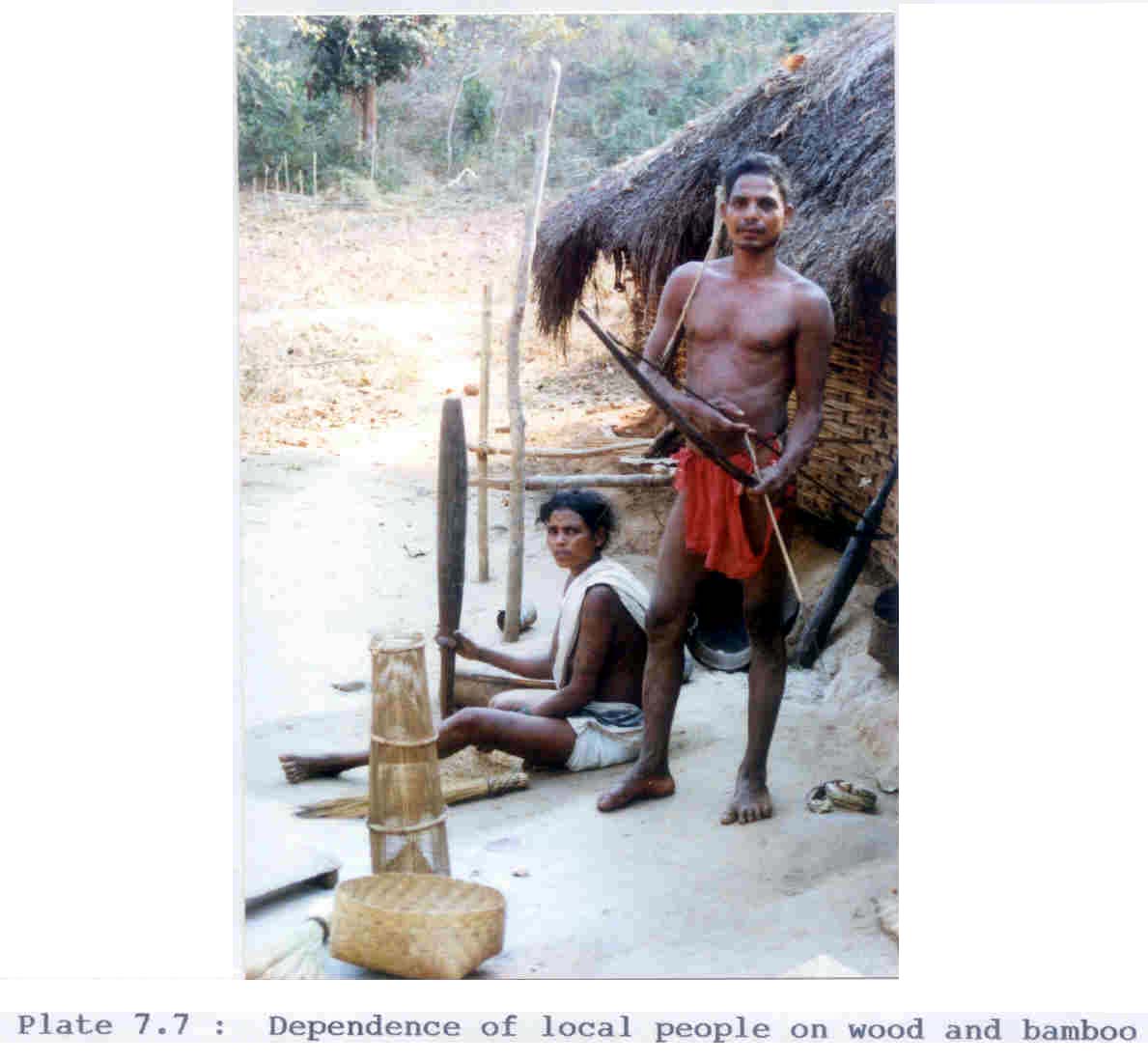
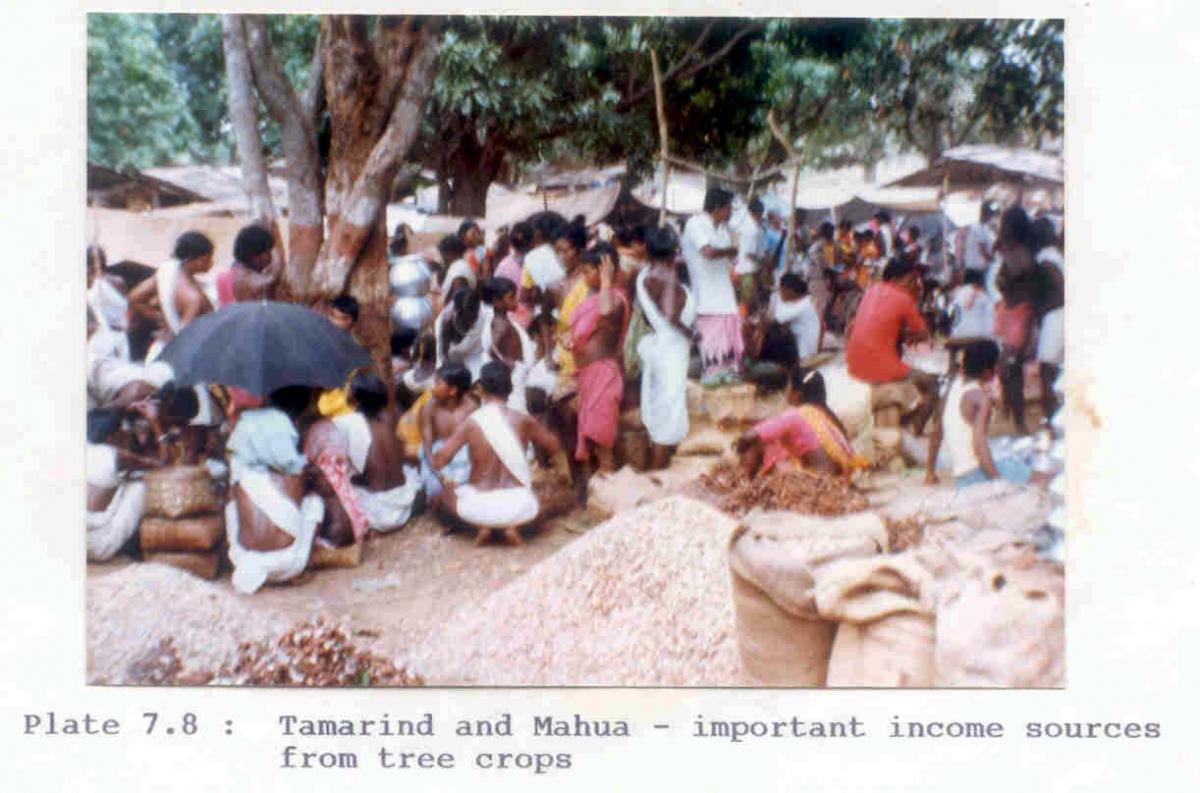
People of the dam side villages (with good forest cover) are deriving greater sustenance from forests as compared to those in villages in the eastern segment where forest is degraded. Collection and sale of forest products variesaccording to land holding and religion and as well as availability in the nearby forest. Landless people collect mahua flowers and seeds and mango fruits from forest and in general are mainly dependent on forests for their overall sustenance, Tendu leaf collection was not organised by forest department in these villages this year.
The extent of dependent on forest for meeting the above needs is shown in brief in table 7.3 for the two different categories of villages in the study area.
Sale of minor products in surplus of domestic use provides 11% of total cash income. However, sustenance provided by forest products domestically used and those sold, through wages form forestry works and through pasturing livestock works ou5t to about 305 as compared to agriculture which provides 52% of the overall sustenance for all the sampled eight villages.
Table 7.3: Extent of dependence on forest for different products.
(Figure are average/household/year)
|
Dependence |
Good forest |
Degraded forest |
Dependence of the |
Extent of dependence |
|
Food |
||||
|
Quantity of food material collected for side (veg. & meat) (kg) |
173 |
108 |
127 |
About half* |
|
Shelter |
||||
|
1. Timber (poles of average 0.35 m girth x 3 m length) (numbers) |
75 |
50 |
69 |
Total |
|
2. Bamboo poles (numbers) |
60 |
10 |
30 |
Total |
|
3. Thatching grass (36% of houses) (kg) |
S75 |
65 |
69 |
Total |
|
Energy |
||||
|
Fuel wood (in tons) |
5.1 |
4.8 |
5 |
Total |
|
Income |
||||
|
From minor forest products (Rs.) |
191 |
15 |
147 |
Total |
|
Other uses |
||||
|
Raw material for making different implements, baskets and material (Bamboo) |
20 |
10 |
15 |
Total |
|
Rope from climbers etc. (metre) |
25 |
5 |
20 |
Substatntial** |
|
Sal leaves for plates (in 100’s) |
18 |
14 |
16 |
Substantial*** |
*Half of this supply comes from purchase in weekly markets.
**Ropes are brought from market by about 25% of the population.
***About 25% of the population uses metal utensils.
Table 7.3 shows that for fuel wood, timber (for construction and fencing) and other raw materials for making implements, people are totally dependent on forest. Another major dependence is for food. Half of the side dishes are made from greens, tubers, bulbs, tender (new year) bamboo shoot, mushrooms, fruits and seeds collected from forests.
Indirect dependence on forest
Cultivation practices
The crop is rain fed. Cereals, millets, pulses, oil seeds and vegetables are cultivated in fields as well as in badi (compound). Listed below are the main crops, pulses and oil seeds cultivated by the people.
|
Local name |
Botanical name |
Common English name |
|
|
Main crops : |
Dhan |
(Oryza sativa) |
Rice |
|
Jondra |
(Zea mays) |
Maize |
|
|
Jondri Jowar |
(Sorghim vulgare) |
Pearl millet |
|
|
Kosra |
(Panicum miliare) |
Millet |
|
|
Kodo |
(Eleucine coracona) |
Finger millet |
|
|
Pulses |
Tur |
(Cajanus indicus) |
Chick pea |
|
Uradh |
(Phaeolus radiatus) |
Black gram |
|
|
Arva |
(Dolichos biflorus) |
Horse gram |
|
|
Oil seeds |
Sarso |
(Brassica nigra) |
Mustard |
|
Til |
(Sesamum indicum) |
Sesamum |
|
|
Arandi, Jada |
(Ricinus communis) |
Castor |
Vegetables are grown in the fenced ‘badi’ around the house.
The land is prepared by ploughing and breaking up mud blocks. Ploughing is done using bullocks, cows and buffaloes. Both bullocks and cows are used in ploughing without any preference to one or the other. Men and women both harness the plough as well as carry out other related works of cultivation. Ploughing start before rain, during Holi festival with a ritual. Before first ritualistic sowing ‘Brij Parad’ (ritual hunting) is performed, the success of which is considered as an indicator for the success in crop production. Although illegal, Parad is believed to be targeted for killing enemies in the crop fields (wild boar, pig, deer, monkey etc.) before cultivation. People nurture a superstitious belief that success of crop is more dependent on b;essing of Goddess than on use of fertilizers or modern methods of cultivation. During our stay at Barsur, cases of human sacrifice (of 3 persons) was reported from a nearby village for getting better crop. ‘Matitiyar’ (occasion for worship of mother earth) id celebrated before every sowing operation
The burnt forest litter washed down during rains to the fields is the main fertilizer. Only the Oriya Brahmins of Binta village are reported to use chemical fertilizer. Farmers in the dam side villages did not use cow dung as manure because of an apprehension that the plants would grow taller and fall before harvest. Weeding is done occasionally but not thoroughly. Yields depends upon rain, protection from disease and pests and weeding, Crops have to be protected day and night in some area by staying on machan and scaring away birds and animals. Harvest is followed by threshing and winnowing with the help of cattle. Crops are reared, thrashed and stored generally in bamboo baskets or mud containers.
Livestock and dependence of forest
Gonds, the major ethnic group of the study area do not milk cow as it is a taboo for them but buffaloes are milked and milk products like ghee are sold. Sale of livestock, milk products and livestock in agriculture provide an average of 7% of their annual income. Since bulk sustenance of cattle comes from pasturing in the forests, about 5% out of 7% of this cash income from livestock can be presumed to be forest based. The average number of livestock per family comes to five cow/bullock, two each of buffalo, sheep and goat and five poultry birds (Appendix 7.6). Pigs are also reared but only by the Gonds. The main purpose of cattle rearing is for agricultural work and cash turnover by sale. The human: bovine ratio in the submergence area is 1:1.3.
Livestock including cows, buffaloes and goats is not stall fed but are seen grazing in forest. Cases of cattle lifting by animals are rare.
Income from agriculture
Agriculture is peoples’ main activity and main source of food and a source of about 39% of total cash income. Twenty percent of actual income is from agriculture labour (Appendix 7.7). An average of 20 quintal paddy is produced per year by land holding families. On average they exchange four quintal for money or other products of wages for labour.
Income from agricultural labour
Landless people provide much of the agricultural labours. It is one of their main sources of food and income. Agricultural labourers are comparatively low paid. About 3 kg is the wage for one day’s work. They are also substantially dependent on collection and sale of forest products. Some are cultivating on encroached forest lands.
Income from forest labour
People get some employment in forest activities e.g. logging, construction of forest roads and plantations. In villages distant from forest, some people mainly work for cutting timber and fire wood for the villagers. Half of the income from labour other than agriculture labour is from this type of employment.
Income from alternative employment
Employment in revenue Department and Forest Department and vacancies on lower grade jobs in Madhya Pradesh Electricity Board Office at Barsoor are very few and only some people in Binta and Harrakoder villages are able to seek employment. Because of illetracy and educational backwardness people are not able to seek or get government jobs except for a few persons mainly from Binta village.
Income from tree crops
Mahua, tamarind, mango and sago palm are the important standing tree crops. Landless people make income from tree crops as they are allowed to collect Mahua flowers from land holders’ compound as well as from forest floor (Plate 7.8). Income from tree crops forms about 11% of total income. A major share of food, liquor and oil, consumed by people is from tree crops like mahua and sago palm (Table 7.4).
Table 7.4 Income from Tree crops
| (Average\household\year) | ||||||||||||
| Village | Mahua | Tamarind | Mango | Mango | Sago palm | Total income | ||||||
| Qty. of flower (kg) | Income by sale (Rs.) | Qty. of seed (kg) | Income by sale (Rs.) | Total income (Rs.) | Qty. (kg) | Income by sale (Rs.) | Qty. (kg) | Income by sale (Rs.) | Tamarind seeds (Rs.) | Income from crops (Rs.) | From tree crops (Rs.) | |
| Koyam | 149 | 98 | 56 | 104 | 202 | 114 | 263 | 100 | 85 | 14 | 19 | 583 |
| Neurnar | 142 | 143 | 30 | 35 | 178 | 60 | 120 | 35 | 15 | 1 | 10 | 324 |
| Puspal | 110 | 75 | 23 | 58 | 133 | 57 | 117 | 48 | 10 | 2 | - | 262 |
| Malewahi | 114 | 83 | 38 | 60 | 143 | 75 | 150 | 33 | 5 | 3 | - | 301 |
| Erpund | 225 | 183 | 42 | 23 | 206 | 98 | 172 | 109 | 63 | 7 | 6 | 454 |
| Harrakodar | 125 | 145 | 16 | 27 | 172 | 85 | 171 | 40 | 19 | 3 | 6 | 371 |
| Sataspur | 48 | 56 | 7 | 5 | 61 | 40 | 38 | 18 | 6 | - | 12 | 117 |
| Binta | 49 | 43 | 8 | 2 | 45 | 32 | 53 | 30 | 17 | - | 3 | 118 |
| Overall | 94 | 92 | 17 | 19 | 111 | 54 | 104 | 39 | 20 | 2 | 7 | 244 |
Mahua, the most useful and respected tree in Bastar needs special mention, as it is an essential part of socio-economic life of Bastar. Mahua flower collection is the main occupation of people for about two months. All people (including children) are seen engaged in collection of flower and driving away cattle to protect fallen flowers. Mahua flower is collected and stored for the entire year’s consumption as well as for sale. Boiled or fried Mahua flowers are eaten as breakfast or as side dish. Alcoholic liquor is distilled from Mahua for consumption, some of which occurs during religious functions. The epicarpal pulp of mahua fruit is edible when it is ripe and the fruits are also used for vegetable. Mahua seed is used for extracting oil which is consumed and the surplus is sold in the market
Mango and tamarind are other marketable cash crops. Sago palm juice (locally known as sulphi) is very a refreshing drink consumed by all (Plate 7.9). The drink ferments quickly and is also used as liquor. Sago palm is considered as a symbol of richness and prosperity. Sulphi drink is sold in the weekly market. Tappong of today from chind (Phonix spl.) is also common.
Income from fishing
Although fishing is common throughout the year, large scale fishing usually occurs during summer. Fishing is mainly done for fish consumption people residing near the weekly market places also sell it to make some additional income from this resource. On an average 20 kilograms of fish is consumed by a household and the cash income from marketed fish is less than 1% of total income. Although Dora is traditionally a fisherman community on the banks of Indravati river, no apparent professional segregation is visible in the study area. However, downstream of Indravati river, Bengali settlers are professional groups engaged in fishing.
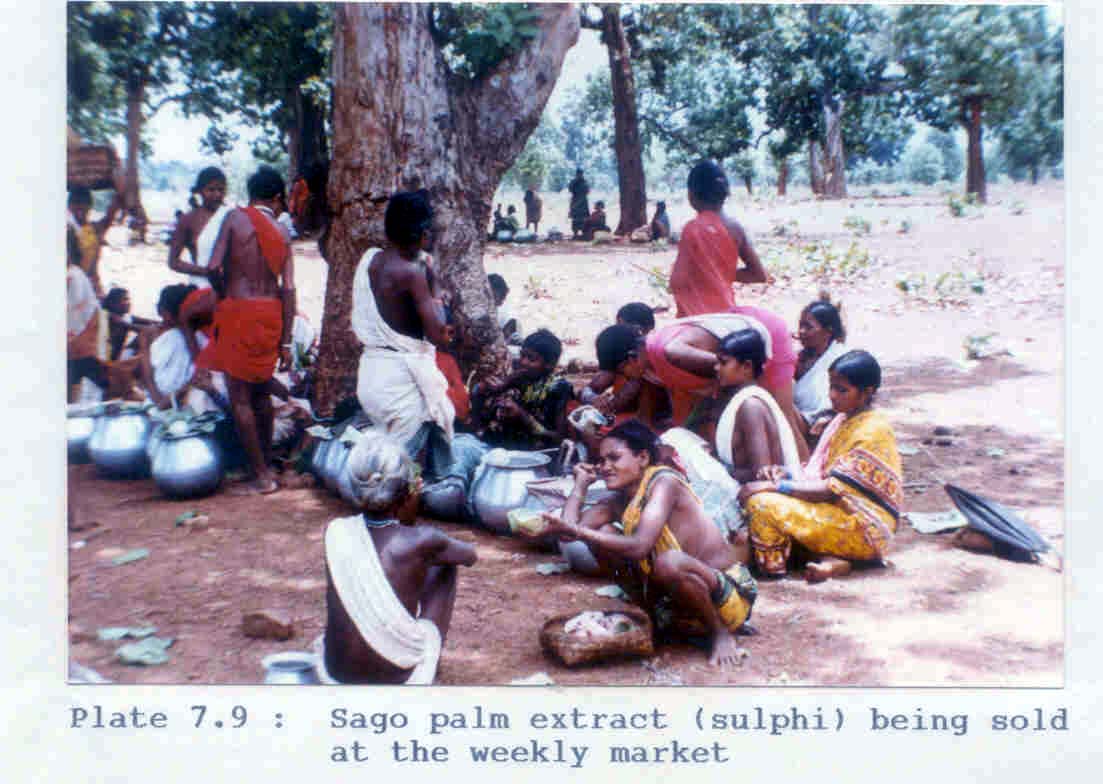
The study was mainly focused on the economic activities of the people and their dependence on forest. Dependent of forest is for different purposes including cultural and economic. Cultural dependence on forest is the result of their belief system, form of recreation, economic occupation and life style. All the rituals of tribals are related to forest. Parad (the annual ritual hunting) is still celebrated in spite of the ban on it. Hunting is the main recreation of young Gond males. Forest is the abode of their deities and totemic animals and objects. Sacred trees of the forest make them more attached to forest
Dependence on forest to meet the economic needs is mainly for food, shelter (timber, bamboo, thatched firewood, pasture, minor products and forestry works. Burnt forest areas nearby also provide fertilizers to the fields below.
A pattern of differential dependence base on difference in seasons, village size, location, land holding size and cultural life of ethnic groups can be recognised in the economic dependence on forest.
Seasonal variation in dependence on forest
Seasonal variation on forest is evident from the calendar of economic activities (Table No. 7.1) given above.
During monsoon people are almost totally dependent on forest for food because of availability of rubbers, mushrooms, bamboo shoots, forest green etc. As they do not go to weekly markets during that period. There is not much income from forest resources. The forest resources during monsoon are only used for food.
Summer is the season of availability of most of the minor forest products like seeds of sal, harra, behead kirich, karanji, kosum, and mahua, honey and silk worm cocoon (kosa). These products are collected and stored for rainy season and are also sold in the market. Summer is thus the period which provides income predominantly from minor forest produce.
In winter, people are very much dependent on forest for fuelwood. Throughout the year, people collect fuelwood from forest for cooking but during winter a fore place (Aggadda) outside the house for warmth is maintained. People even made fire around the place where they sleep. During the day time also one or two pieces of logs are seen forever burning to provide ready source of fire.
Village wise variation in dependence on forest
Dam side villages are comparatively small and hamlets are not far from forests. They are much more dependent on forest for their food, income, fuel wood and other needs like timber and thatch for construction of house, cultivation and livestock keeping, than the villages which are distant from forests (eastern segment villages). Dam side villages, households derive on an average 11% of their annual income from minor forest products, while distant village households make only 1% of it from minor forest products. The dam side village households consume more forest food and fuel wood as they are located in better forested areas and have an easy access to forest resources. Variation in forest dependence of dam side villages and distant villages is also a result of variation in economic condition and the religion of the people of villages of eastern and western segment.
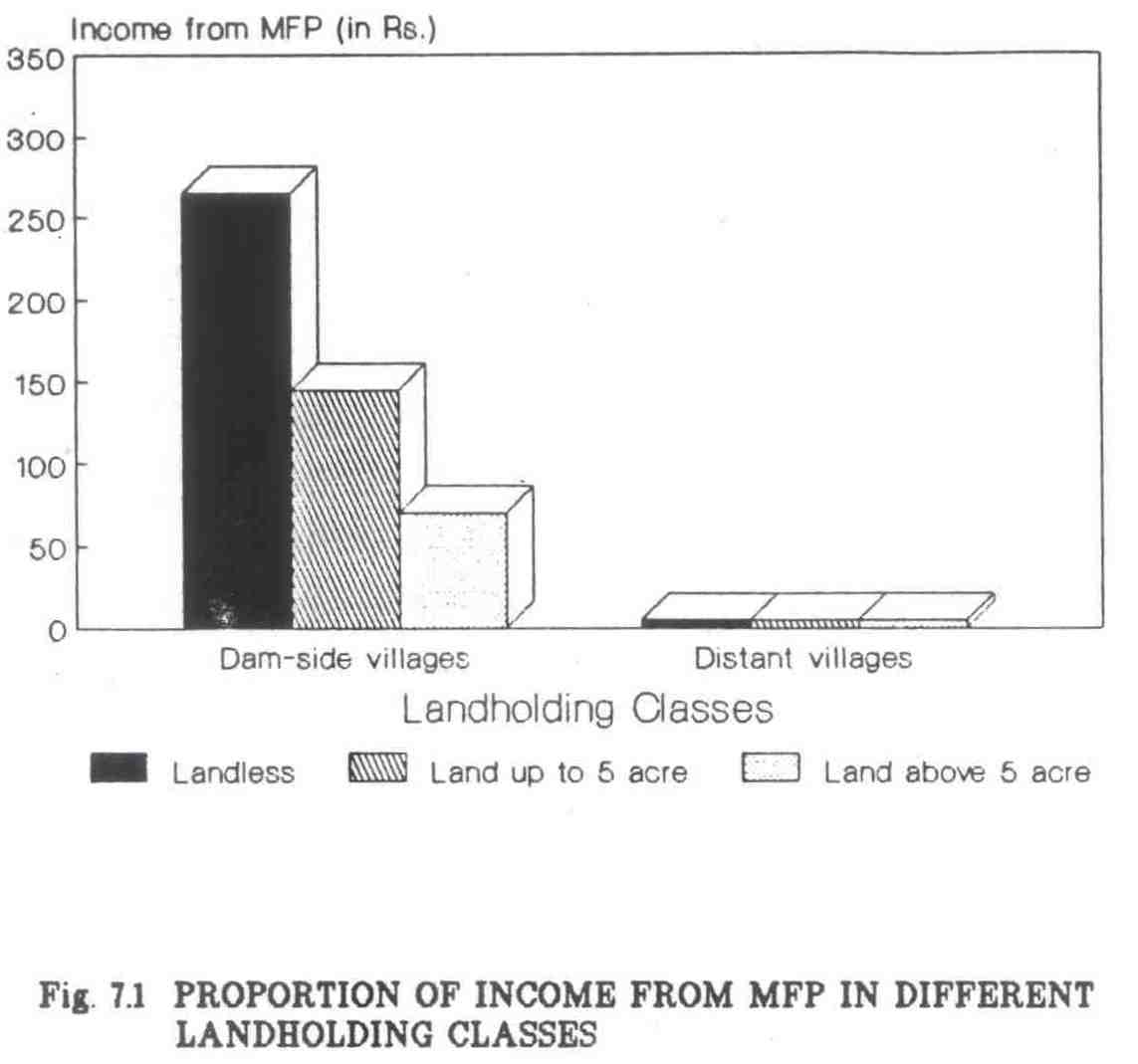
Land holding and size variation dependence on forest
On the basis of land holdings, household. Can be differentiated in three broad categories (1) landless households (2) households with land holdings up to 5 acres and (3) households with land holding more than 5 acres (Table 7.5)
In dam side villages, 26% of households are landless, 29% households are with 5 or less than 5 acres land and 45% are having more than 5 acres of land. These percentages of land holding classes are 28%, 25% and 25% respectively for landless, < 5 acre and > 5 acre land households in distant villages.
In the dam side villages a landless household earns about 259 rupees by selling minor forest products, bur the landless household of the eastern segment villages get only one rupees (on an average) from M.F.P. (Fig. 7.1). Landless people collect mahua flowers and seed, mango fruits and seeds etc. from forest land more often and their income from tree crops is dependent on forest. In dam side villages a landless household earns 124 rupees from tree crops while in distant villages a landless household earns only 10 rupees from tree crops. Forest food consumption of landless households dam side villages is about one and a half times more than that of landless household in distant villages (98 kg only).
Table 7.5 Land holding classes and differential dependence on forest
(Average/household/year)
| Land holding classes | Actual income from sale of product/employment | Forest food consumption/ household/ (kg.) | ||||||||
| Live stock | Agri. | Tree crops | M.F.P. | Agri. Labour | Other labour or service | Fishing | Total | |||
| Dam side village | landless | 118 | - | 124 | 259 | 779 | 93 | 63 | 1436 | 157 |
| Land up to 5 acres | 180 | 392 | 298 | 149 | 141 | 511 | 27 | 1698 | 153 | |
| Land more than 5 acres | 252 | 858 | 540 | 70 | 18 | 157 | 5 | 1900 | 89 | |
| Distant villages | Landless | 141 | - | 10 | 1 | 845 | 272 | 31 | 1300 | 98 |
| Land up to 5 acres | 207 | 49 | 68 | 5 | 809 | 487 | 13 | 1634 | 87 | |
| Land more than 5 acres | 228 | 1884 | 310 | - |
24 | 820 | - | 3266 | 65 | |
| Overall | Landless | 131 | - | 62 | 119 | 815 | 190 | 46 | 1363 | 125 |
| Land up to 5 acres | 197 | 161 | 154 | 56 | 558 | 496 | 18 | 1640 | 105 | |
| Land more than 5 acres | 243 | 1259 | 450 | 42 | 20 | 417 | 3 | 2434 | 80 | |
Dam side villages show much more dependence on forest food than distant villages (Fig. 7.2). Fuelwood consumption per household is also higher in dam side villages.
Land holdings and dependence on forest shows a reverse relationship. Landless people in dam site villages are the most dependent population on forest, people with land holdings upto 5 acre is less dependent than landless and
people with land more than 5 acres are the least dependent on forest among all
Dependence on forest of different ethnic groups
Dependence on forest seems to vary according to tribes and castes. Appendix 7.8 gives a detailed information of different tribes and castes and different in forest dependence
Gond tribals (Bisonhorn Maria, Jhoria Muria and Raja Muria) are most dependent on forest in terms of income from forest products, forest food consumed and fuelwood consumed. Gonds in villages near the dam side derive maximum benefit from forest in comparison to Gonds of other areas within the submergence. Schedule caste comes next in order in terms of dependence on forest, while Hindu casts are least dependent. Oriya Brahmins are the least dependent on forest among all Hindu groups.
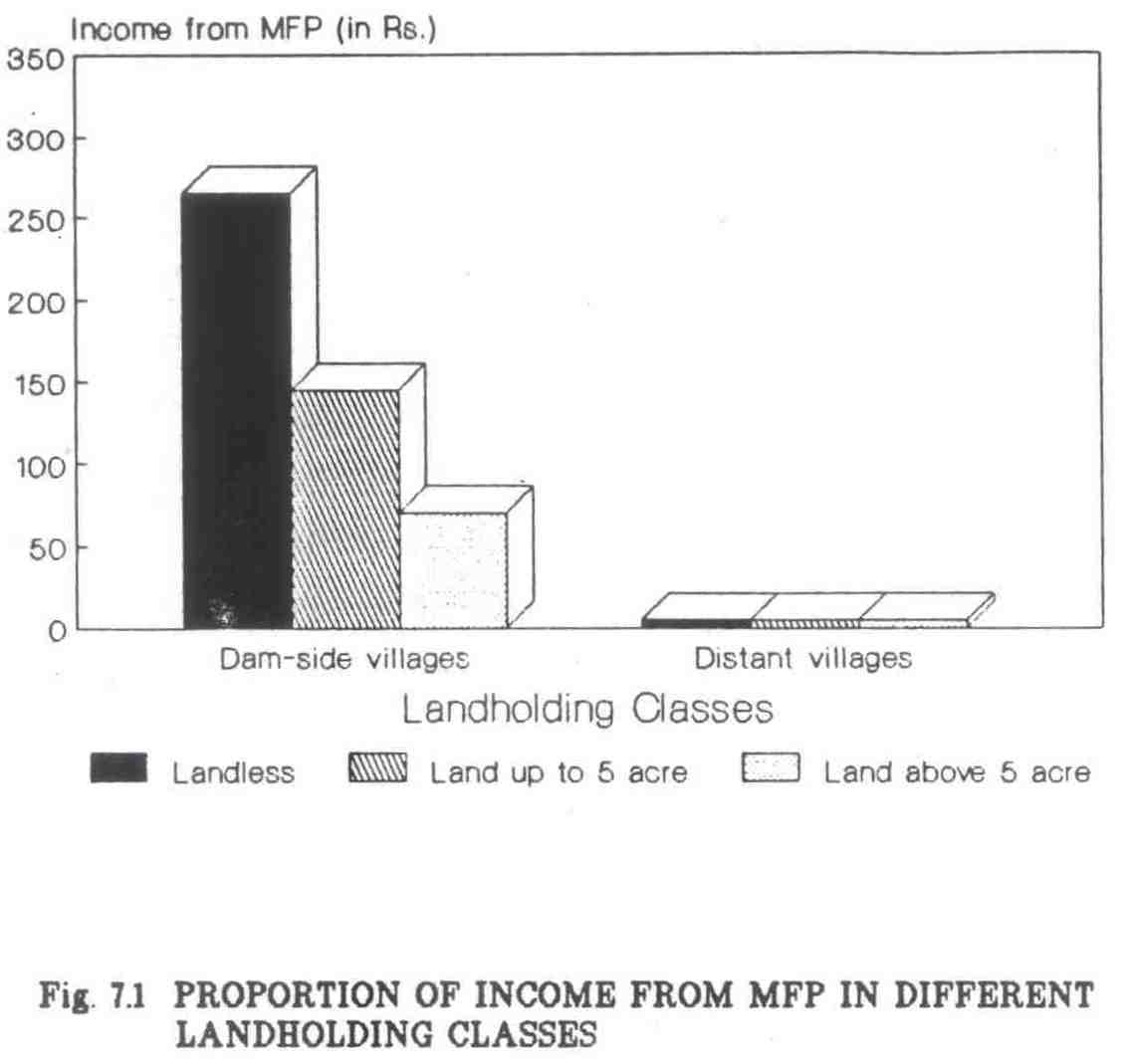
Last Updated: December 12, 2015









